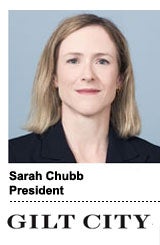 Sarah Chubb, widely respected as the person who helped form Condé Nast’s digital division over a decade ago, has joined online luxury deals site Gilt Groupe’s local site network Gilt City as its President. Read the release.
Sarah Chubb, widely respected as the person who helped form Condé Nast’s digital division over a decade ago, has joined online luxury deals site Gilt Groupe’s local site network Gilt City as its President. Read the release.
A magazine vet through two decades, most of which was at Condé Nast, Chubb left the publisher after 20 years in Feb. 2011. She rose from Vogue’s ad manager in 1991 to become director of CondéNet in 1996, where she built web-only sites like Epicurious.
Gilt City represents the high-end aura of the Condé Nast titles, and in marrying deals and advertising, it’s a natural progression for Chubb, who sought to move the publisher into less traditional areas. She spoke with us about her decision a week before she officially starts her new job.
Why did you decide to take this post?
I’ve been watching them from very early on as a customer and as someone working in media. I’ve known Kevin Ryan for some time. I’m also a big fan of him and Susan Lyne. I’m interested in the way they have disrupted and redefined the sale and marketing of high-end fashion. They really created the flash sale phenomenon in many ways.
I took this post because local is poised to explode. Local businesses know that they need to get smarter and better in terms of using the Internet. Yelp has done a lot to further that and influence that activity. A year from now, you’ll see most local businesses, especially high-end ones, using tools to market their offerings that weren’t available a few years ago. The combination of how strong the Gilt brand is with certain kinds of high-end consumers, and the customer database, which keeps the insights up and the costs down on customer acquisition, is something great to be a part of.
What is the approach in terms of the ad strategy that is aimed at individual cities?
New York is its own animal, Boston is a slightly different market, but the people Gilt City is aimed at – upwardly mobile people in their second or third jobs. The tagline is “Love your city more.” These are people who have chosen to be in places for specific reasons, largely around career and lifestyle. They want to go out and experience these places. They may not be making as much as they might a few years from now, but they do want to spend what they’re making.
As for the advertising mix, there’s a lot of growth along the particular categories Gilt City caters to. Entertainment-driven marketing, is a good example. Venues and events around music or theater are increasingly important. Restaurants are a natural area for local and they tend to reflect the fabric of a particular city. National brands have strong presences in the cities we cover, and they’re looking for a more one-on-one conversation with consumers. For example, Gilt City announced a partnership with Mastercard last week, which promotes places that have exclusive relationships with that credit card.
What’s the advertising proposition for a brand advertiser?
Gilt’s customers are very attached to their businesses. The ability to use the customer relationships and purchasing data for cross-marketing is tremendous. These are businesses that are built on outreach and email. There’s a lot of space to grow in using data in better and better ways.
Any programmatic or exchange platform focus for Gilt City?
No, it’s all direct sales and a premium brand focus. We have products every day that need to be a cross between curation and sales. And at this point, programmatic buying doesn’t provide the flexibility for our individual, customized model.











